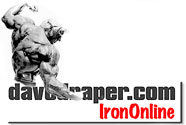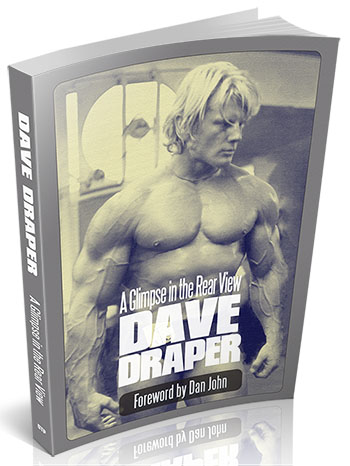The Ketogenic Diet
A Complete Guide for the Dieter and Practitioner
By Lyle McDonald
Brand new: Lyle's new book, Ultimate Diet 2 -- Click here for an excerpt
Ketogenic diets and bodybuilders/athletes
Low carbohydrate diets were used quite often in the early years of bodybuilding (the fish and water diet). As with general fat loss, the use of low carbohydrate, ketogenic diets by athletes fell into disfavor as the emphasis shifted to carbohydrate based diets.
As ketogenic diets have reentered the diet arena in the 1990’s, modified ketogenic diets have been introduced for athletes, primarily bodybuilders. These include so-called cyclical ketogenic diets (CKD’s) such as “The Anabolic Diet” and “Bodyopus.”
During the 1980’s, Michael Zumpano and Daniel Duchaine introduced two of the earliest CKD’s: “The Rebound Diet” for muscle gain, and then a modified version called “The Ultimate Diet” for fat loss. Neither gained much acceptance in the bodybuilding subculture. This was most likely due to difficulty in implementing the diets and the fact that a diet high in fat went against everything nutritionists advocated.
In the early 1990’s, Dr. Mauro DiPasquale, a renowned expert on drug use in sports, introduced "The Anabolic Diet.” This diet alternated periods of 5-6 days of low carbohydrate, moderate protein, moderate/high fat eating with periods of 1-2 days of unlimited carbohydrate consumption. The major premise of the Anabolic Diet was that the low carb week would cause a ‘metabolic shift’ to occur, forcing the body to use fat for fuel. The high carb consumption on the weekends would refill muscle carbohydrate stores and cause growth. The carb loading phase was necessary as ketogenic diets can not sustain high intensity exercise such as weight training.
DiPasquale argued that his diet was both anti-catabolic (preventing muscle breakdown) as well as overtly anabolic (muscle building). His book suffered from lack of appropriate references (using animal studies when human studies were available) and drawing incorrect conclusions. As well, his book left bodybuilders with more questions than it provided answers.
A few years later, bodybuilding expert Dan Duchaine released the book “Underground Bodyopus: Militant Weight Loss and Recomposition.” Bodyopus addressed numerous topics related to fat loss, presenting three different diets. This included his approach to the CKD, which he called Bodyopus. Bodyopus was far more detailed than the Anabolic Diet, giving specific recommendations and went into more detail regarding the physiology of the diet.
However, “Bodyopus” left many questions unanswered as evidenced by the numerous questions appearing in magazines and on the internet. While Duchaine’s ideas were accepted to a limited degree by the bodybuilding subculture, the lack of scientific references led health professionals, who still thought of ketogenic diets as dangerous and unhealthy, to question the diet’s credibility.
Introduction to the ketogenic diet
Many readers may not be familiar with the ketogenic diet. This chapter discusses some general ideas about ketogenic diets, as well as defining terms that may be helpful.
In the most general terms, a ketogenic diet is any diet that causes ketone bodies to be produced by the liver, shifting the body’s metabolism away from glucose and towards fat utilization. More specifically, a ketogenic diet is one that restricts carbohydrates below a certain level (generally 100 grams per day), inducing a series of adaptations to take place. Protein and fat intake are variable, depending on the goal of the dieter. However, the ultimate determinate of whether a diet is ketogenic or not is the presence (or absence) of carbohydrates.
Fuel metabolism and the ketogenic diet
Under ‘normal’ dietary conditions, the body runs on a mix of carbohydrates, protein and fat. When carbohydrates are removed from the diet, the body’s small stores are quickly depleted. Consequently, the body is forced to find an alternative fuel to provide energy. One of these fuels is free fatty acids, which can be used by most tissues in the body. However, not all organs can use free fatty acids. For example, the brain and nervous system are unable to use free fatty acids for fuel; however they can use ketone bodies.
Ketone bodies are a by-product of the incomplete breakdown of free fatty acids in the liver. They serve as a non-carbohydrate, fat-derived fuel for tissues such as the brain. When ketone bodies are produced at accelerated rates, they accumulate in the bloodstream, causing a metabolic state called ketosis to develop. Simultaneously, there is a decrease in glucose utilization and production. Along with this, there is a decrease in the breakdown of protein to be used for energy, referred to as ‘protein sparing.’
Many individuals are drawn to ketogenic diets in an attempt to lose bodyfat while sparing the loss of lean body mass.
………
Taken
from pages 11, 15-16 of The Ketogenic Diet
Copyright Lyle McDonald
Lyle's book, Ultimate Diet 2 -- Click here for an excerpt
Click here to read an excerpt from Lyle's Rapid Fat Loss e-book
Here's an excerpt from A Guide to Flexible Dieting, Lyle's latest work
For advanced dieting and hormone manipulation, check out Rob Faigin's Natural Hormonal Enhancement
Click here to get yourself some low-carb Bomber Blend protein
Click here to learn about training on a low carb, ketogenic diet
What are the downfalls of ketogenic dieting?
What can I expect on a keto diet?
Are supplements needed on a low carb diet?

